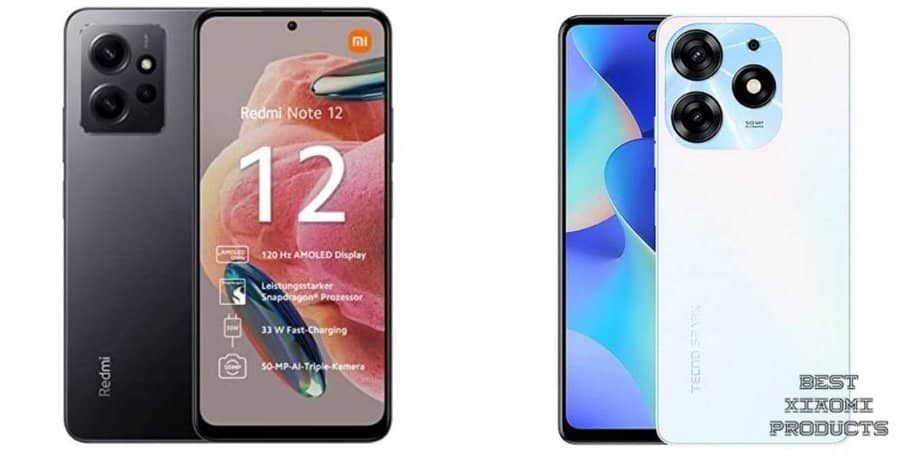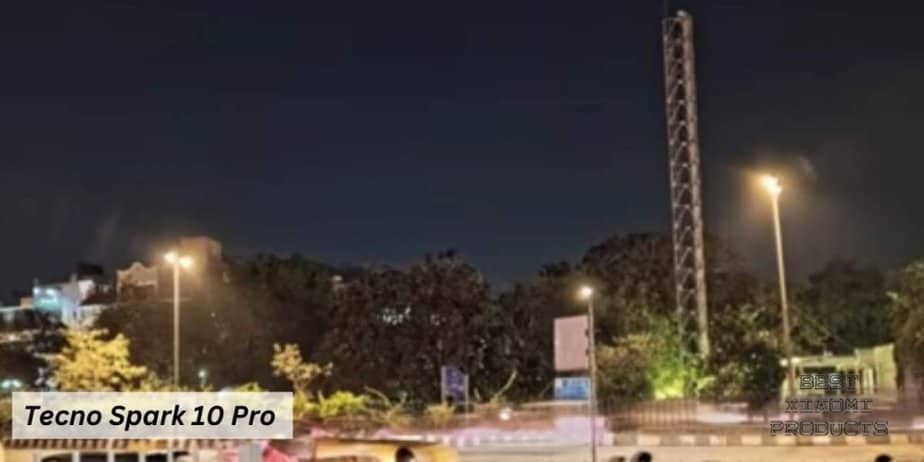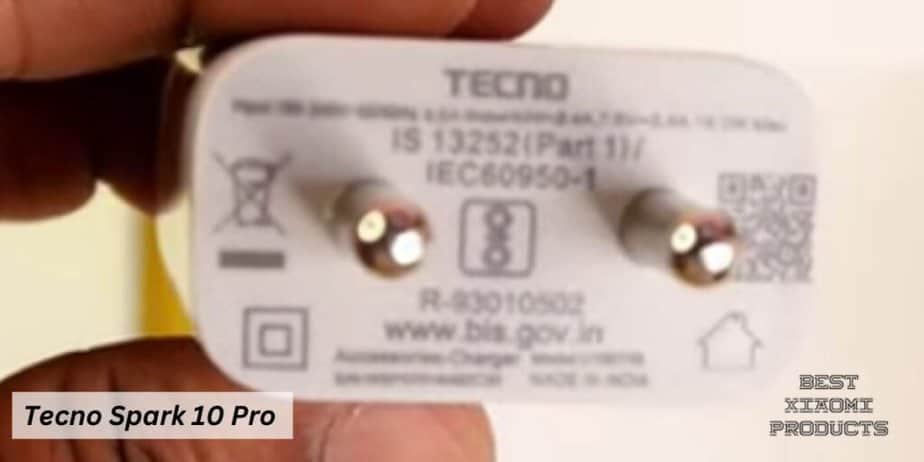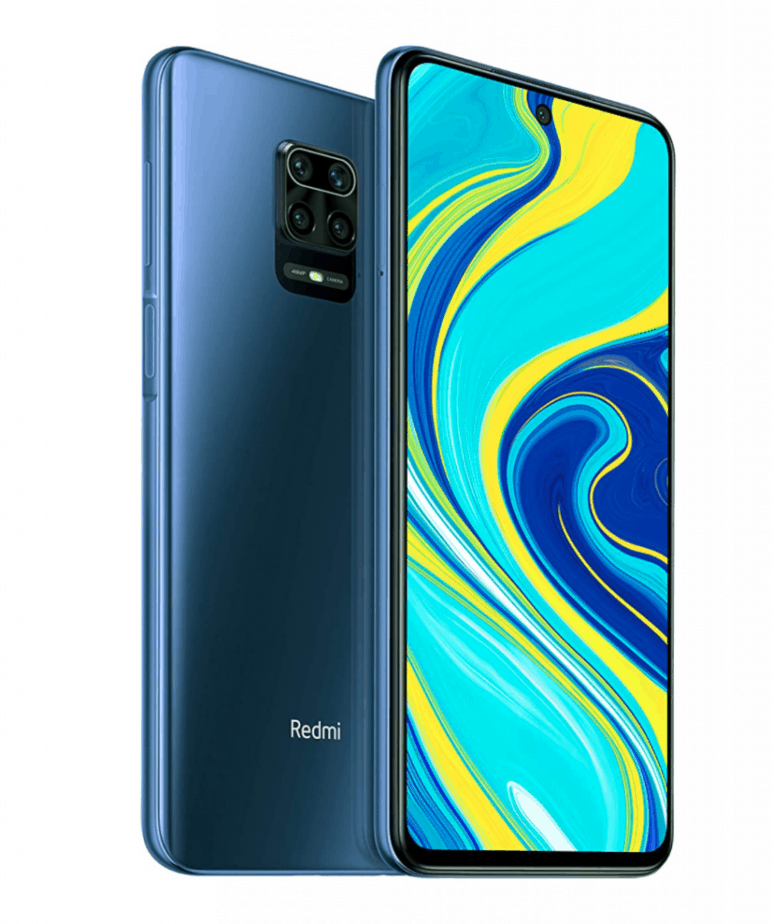In the ever-evolving smartphone landscape, two brands, Xiaomi and Tecno, have carved their niches.
Xiaomi, a veteran known for its feature-packed devices at competitive prices, continues to dominate the market. Tecno, a rising star, particularly in emerging markets, offers budget-friendly options with a focus on camera capabilities.
But with both brands offering a wide range of smartphones across various price points, choosing between them can be daunting.
This analysis delves deep into the strengths and weaknesses of Xiaomi and Tecno in 2024, considering factors like performance, camera quality, battery life, software, and price, to help you pick the brand that best suits your needs and budget.
Related: Xiaomi vs Umidigi
Xiaomi vs Tecno
Xiaomi Redmi Note 12 vs Tecno Spark 10 Pro

Looking for the best midrange smartphone in 2023? Two great options are the Tecno Spark 10 Pro and the Redmi Note 12 4G.
Both the Xiaomi Redmi Note 12 and Tecno Spark 10 Pro are great mid-range smartphones with their unique strengths and weaknesses.
In terms of pricing, the Tecno Spark 10 Pro is more affordable, while the Redmi Note 12 4G is more expensive.
The Redmi Note 12 4G boasts a superior display, sharper rear camera with an ultrawide lens, and better performance with a more power-efficient chipset.
However, the Tecno Spark 10 Pro has a bigger memory, better selfie camera, and supports up to 256GB ROM storage.
Both phones have a 5,000 mAh battery, but the Redmi Note 12 4G charges faster with 33W fast charging technology.
| Specification | Xiaomi Redmi Note 12 4G | Tecno Spark 10 Pro |
|---|---|---|
| Price (starting) | $195 for 4+128 GB | $130 for 8+128 GB |
| $215 for 6+128 GB | $210 for 8+256 GB | |
| Display | 6.67-inch FHD+ Super AMOLED with 120Hz refresh rate and Corning Gorilla Glass 3 protection, IP53 dust and splash resistance | 6.8-inch FHD+ IPS LCD with 90Hz refresh rate |
| Rear Camera | 50MP main camera, ultrawide lens | 50MP main camera |
| Front Camera | 13MP | 32MP |
| Video Recording | 1080p | 1080p |
| Chipset | Qualcomm Snapdragon 685 4G, 6nm fabrication process | MediaTek Helio G88, 12nm fabrication process |
| Battery Efficiency | More efficient | So-So |
| Software | Android 13 with up to two years of software upgrades | Android 13 |
Affordability: Tecno Spark 10 Pro Takes the Crown
Let's start with the price. The Tecno Spark 10 Pro is more affordable than the Redmi Note 12 4G. The 8+128 GB storage model starts at approximately $130, while the 8+256 GB storage model goes up to approximately $210.
Whereas, the Redmi Note 12 4G has a starting price of approximately $195 for the 4+128 GB storage and goes up to approximately $215 for the 6+128 GB trim.
Display: Redmi Note 12 4G Takes the Lead


When it comes to the display, the Redmi Note 12 4G wins the gold medal. It boasts a 6.67-inch FHD+ Super AMOLED touchscreen with 120Hz refresh rate support, protected by Corning Gorilla Glass 3 and IP53 dust and splash resistance.
Meanwhile, the Tecno Spark 10 Pro offers a 6.8-inch FHD+ IPS LCD touchscreen with 90Hz refresh rate support. The Redmi Note 12 4G's screen is sharper, brighter, and smoother than that of the Tecno Spark 10 Pro.
Camera: Tecno Spark 10 Pro Wins for Selfies, Redmi Note 12 4G for Rear Setup
The camera aspect is a bit mixed up between these two smartphones. If you're looking for a better selfie camera, the Tecno Spark 10 Pro is the better option with its 32MP front cam, perfect for vlogging.


When it comes to the rear setup, the Redmi Note 12 4G has more advantages. It’s more versatile with an ultrawide lens, while both smartphones have 50MP main cameras.
If you want a sharper and crisper selfie camera, go for the Tecno Spark 10 Pro. But if you want a more versatile back camera, the Redmi Note 12 4G is the best option. It's important to note that both phones can only record video in 1080p quality.
Performance and Software: Redmi Note 12 4G Takes the Lead
The Redmi Note 12 4G is a leap ahead when it comes to performance. It is powered by the Qualcomm Snapdragon 685 4G chipset fabricated on a 6nm node, as opposed to the MediaTek Helio G88 that powers the Tecno Spark 10 Pro, built on a 12nm node.



The Redmi Note 12 4G is more battery efficient and cooler during heavy loads. Software-wise, both smartphones run Android 13 out of the box, but the Redmi Note 12 4G is certain to get up to two years of software upgrades. This is one major advantage of getting the Redmi Note 12 4G.
Xiaomi Redmi Note 11 vs Tecno Camon 17
| | Xiaomi Redmi Note 11 | Tecno Camon 17 |
 |
 |
|
| Display | 6.43-inch AMOLED 2400 x 1080 pixels 90 Hz | 6.8-inch IPS LCD 2460 X 1080 pixels 90 Hz |
| Processor | Snapdragon 680 | Mediatek G85 |
| RAM | 4 GB | 6 GB |
| Storage | 64/128 GB | 64/128 GB |
| Battery | 5,000 mAh 33W Fast Charging | 5,000 mAh 18W Fast Charging |
| Camera | 50 MP f/1.8 (Wide) 8 MP f/2.2 (Ultra Wide) 2 MP f/2.4 (Macro) 2 MP f/2.4 (Depth Sensor) with autofocus |
64 MP f/1.79 (Wide) 2 MP f/2.4 (Macro) 2 MP f/2.4 (Portrait) |
| Connectivity | Wi-Fi 802.11 a/b/g/n/ac Wi-Fi Direct with hotspot Bluettoth 5.0, A2DP, LE A-GPS, GLONASS, GALILEO FM radio built-in antenna USB Type-C 2.0 |
Wi-Fi 802.11 b/g/n/ac Wi-Fi Direct with hotspot Bluetooth 5.0, A2DP, LE Yes, with A-GPS, GLONASS, GALILEO FM radio USB Type-C 2.0 |
| IP Rating | - | IP 53 Rating |
| Sound | Loudspeaker, 3.5mm Headphone Jack | Loudspeaker, 3.5mm Headphone Jack |
| Security | Fingerprint, Face Unlock | Fingerprint, Face Unlock |
| Software | Android 11-based HIOS 8.0 | Android 11-based MIUI 12.5 |
Design & Build Xiaomi vs Tecno
Both the Xiaomi Redmi Note 11 and the Tecno Camon 17 phones are similarly priced and so unsurprising they look and feel similar. Both devices have plastic backs and they look similar both on the front and the back.
On the front, you’ll find a hole punch selfie camera and a fairly thin chin on both smartphones for the price. This makes them look identical at first glance. The only big difference from the front is the design and placement of the volume rocker, and power button.
Overall, I would say that when it comes to design both phones are equal in terms of looks and quality. I like the gradient color scheme on the back but I don’t like either phone’s camera island/bump. And on the front, they both look almost identical. Though both phones feel built well for the price too, so I have no complaints.
Display Xiaomi vs Tecno

While the front design is similar for both the Xiaomi Redmi Note 11 and the Tecno Camon 17, they both differ in the type of displays used. I feel like this is where most people will notice a big difference between the phones and might even make or break the deal for most people.

Xiaomi uses a 6.43-inch AMOLED display that outputs 2400 x 1080 pixels with a 90Hz refresh rate. This makes it a sharp display. It is impressive when it comes to the brightness and color reproduction given the price. The colors are vivid and bright, and the display has a nice dynamic range too. It is great for videos and movies thanks to the small punch hole for the selfie camera.
The display on the Camon 17 is considerably worse as it’s a 6.8-inch screen with just an LCD panel. While a 90 Hz refresh rate is good, almost every phone in this price category features AMOLED panels, so Tecno Camon 17 falls behind.
Displays are an important factor when it comes to phones as you will be looking at them almost every time you use the phone. I hope Camon comes with better displays in their future models.
Performance Xiaomi vs Tecno
Performance for a phone is primarily determined by the processor it uses and the RAM available for it. Xiaomi Redmi Note 11 uses a Snapdragon 680 processor (SOC) coupled with 4 GBs of RAM. In comparison, the Tecno Camon 17 is equipped with a Mediatek G85 SOC along with 6 GBs of RAM.
The Snapdragon 680 found on the Redmi Note 11 is significantly faster than Mediatek G85. In fact, the G85 is slower than the G70 found on the older Camon 16 by a small margin. This makes the Note 11 a better choice for performance enthusiasts.
The Redmi Note 11 is the better performer of the two and if you are someone that’s looking to play games, then the Redmi Note 11 will perform much better, smoother, and provide higher details compared to the Camon 17.
If performance is something very important to you, especially graphical performance, then you should choose the Redmi Note 11 over the Camon 17. The Redmi Note 11 is a gamer’s delight in this price category, making it very attractive to the average budget mobile gamer.
Camera
Cameras on low-midrange smartphones are not the most exciting part of the phones and they don’t sway much when it comes to choosing the phone for the average consumer. But regardless, I have tested these two devices, and here are my thoughts.
On the back, the Xiaomi Redmi Note 11 comes with a quad-camera setup with a 50 MP primary wide sensor, an 8 MP ultrawide sensor, a 2 MP macro, and a 2 MP depth sensor. Xiaomi has been a phone manufacturer for quite some time now, so camera quality is better than most brands in the price range.
The Redmi Note 11 can take some excellent shots in daylight with very good detail and colors. It struggles at night time but so will any phone in this price range. The Redmi Note 11 excels the most in the ultrawide category. The macro and depth sensors are very mediocre like most phones in this price range. Overall, I am pleased with the rear cameras on the Xiaomi Redmi Note 11 for the price it commands.
The Redmi Note 11 comes with a 13 MP selfie camera which does its job of taking good selfies. My complaint here is that the post-processing is too high and so the selfies lack facial detail.
The Tecno Camon 17 uses a quad-camera setup too at the back but comes with different sensor sizes. The Camon 17 is equipped with a 64 MP primary wide sensor, along with an ultrawide, macro, and depth sensor, all of which capture 2 MP pictures.
The main sensor like the Note 11 takes detailed and clear shots when there’s a lot of light but struggles under artificial light or at night. The ultrawide, macro and depth sensors all are mediocre at taking pictures, making them useless most times.
The Camon 17 ships with a 16 MP wide selfie camera, which enables it to take better selfies and fit in more information in the picture. The 16 MP wide selfie lens produces images that have more facial detail than the Note 11 but the colors are a little washed out.
All things considered, I would choose the Note 11 if you are someone who takes a lot of photos with your rear cameras, while the Camon 17 is better for selfies.
Battery
Both the phones in comparison come with the same battery capacity, with both of them sporting a 5000 mAh battery.
This translates into similar battery life for both, 16 hours for the Camon 17, and 15 hours for the Note 11 in our video loop test.
Xiaomi did have a higher drop when gaming compared to the Camon 17, while the opposite was true for everyday tasks with the Camon 17.
Overall, you won’t be disappointed in the battery life of either phone. But you will be disap[pointed with the Camon 17’s charging speed. The Camon 17 features only 18W charging speeds, while Xiaomi offers 33W with the Redmi Note 11.
So, battery life similar to much faster-charging speeds gives the win to Redmi Note 11.
Xiaomi vs Tecno - Conclusion
The Tecno Camon 17 falls behind when it comes to display, performance, and charging speed. It puts up a good fight in the camera, battery life, and build department. But all o this is not enough to justify buying it over the Redmi Note 11.
Both phones have poor software but I still prefer Redmi Note 11 over the Camon 17. Camon 17 does offer more RAM and Storage at the same price, but this is not enough to make it the better buy. I would recommend spending extra for the extra RAM and Storage in the Redmi Note 11.
Xiaomi Redmi Note 9 Pro vs Tecno Camon 16
| Xiaomi Redmi Note 9 | Tecno Camon 16 | |
| Display | 6.53-inch IPS LCD 2340 x 1080 pixels | 6.8-inch IPS LCD 1640 X 720 pixels |
| Processor | Mediatek G85 | Mediatek G70 |
| RAM | 4 GB | 4 GB |
| Storage | 64 GB | 64 GB |
| Battery | 5,020 mAh | 5,000 mAh |
| Camera | 48 MP, f/1.8, 26mm (wide) 8 MP, f/2.2, (ultrawide) 2 MP, f/2.4, (macro), AF 2 MP, f/2.4, (depth) |
64 MP, 26mm (wide) 2 MP, f/2.2 (ultrawide)2 MP, f/2.4, (macro) 2 MP, f/2.4, (depth) |
| Connectivity | Wi-Fi 802.11 a/b/g/n/ac, dual-band, Wi-Fi Direct, hotspot 5.0, A2DP, LE Yes, with A-GPS, GLONASS, GALILEO FM radio, built-in antenna USB Type-C 2.0 |
Wi-Fi 802.11 b/g/n/ac, dual-band, Wi-Fi Direct, hotspot 5.0, A2DP, LE Yes, with A-GPS, GLONASS, GALILEO FM radio micro-USB 2.0, USB On-The-Go |
| Sound | Loudspeaker, 3.5mm Headphone Jack | Loudspeaker, 3.5mm Headphone Jack |
| Security | Fingerprint, Face Unlock | Fingerprint, Face Unlock |
| Software | Android 10 based HIOS 7.0 | Android 10 based MIUI 12 |


Design & Build Xiaomi vs Tecno
Both the Xiaomi Redmi Note 9 and the Tecno Camon 16 phones are similarly priced and so unsurprising they look and feel similar. Both devices have plastic backs and they look similar both on the front and the back.
On the front, you’ll find a hole punch selfie camera and a fairly thick chin on both smartphones. This makes them look identical at first glance. The only big difference from the front is the design and placement of the volume rocker, and power button.
On Redmi Note 9, you will get a single button for the volume rocker beneath which you’ll find the power button. On the Camon 16, there are separate physical buttons for volume up and down along with a separate power button below them. I prefer the Camon 16 in this regard as the buttons are also lower making it better to use especially when single-handed. Separate buttons are also aesthetically better and easy to distinguish.
When you flip both phones, you will be easily able to distinguish between the two, yet they look similar. Both phones use a boxy camera cutout at the top of the phone. The Redmi Note 9 employs a black rectangular cutout that houses the fingerprint sensor under the camera. On the other hand, the Camon 16 uses a square black camera island, the fingerprint sensor which is not a part of the camera island is below it.
The Redmi Note 9 shows off the ‘Redmi’ branding horizontally at the bottom of the phone, while the Tecno Camon 16 uses a vertical ‘Tecno Camon’ branding. Both phones also use a slightly gradient color finish and I like the color finish on both phones.
Overall, I would say that when it comes to design both phones are equal in terms of looks and quality. I like the gradient color scheme on the back, I don’t like either phone’s camera island/bump. And on the front, they both look almost identical. Both phones feel built well for the price too, so I have no complaints about each.
Check out Xiaomi phones on Aliexpress
Check out Tecno phones on Amazon
Display Xiaomi vs Tecno
While the display layout and design are the same for the Xiaomi Redmi Note 9 and the Tecno Camon 16, they both use a very different class of displays and perform in different classes too. I feel like this is where most people will notice a big difference between the phones. And might even make or break the deal for most people.
Xiaomi uses a 6.53-inch display that outputs 2340 x 1080 pixels. This makes it a sharp display. It is also equally impressive when it comes to the brightness and color reproduction given the price. The colors are vivid, and bright, and the display has a nice dynamic range too. It is great for videos and movies thanks to the small punch hole for the selfie camera.
Now you might be thinking since both phones look the same from the front, there should be very little setting them apart when it comes to the displays, but no. The display on the Camon 16 is considerably worse as it’s a 6.8-inch screen with just an HD class display. This means it outputs at only 1640 x 720 pixels, making it noticeably less sharp. While the color reproduction and dynamic range are fine, the display can seem pixelated, especially when playing videos.
Tecno should have gone with a FullHD class display as no phone close to this price should use an HD display. To make things worse, the Camon 16 has a bigger screen, making it even less sharp than if it used a 6.53-inch display like Xiaomi.
I would never recommend the Camon 16 over the Redmi Note 9 unless it can beat the Redmi Note 9 by quite some margin in the other categories. Displays are an important factor when it comes to phones as you will be looking at them almost every time you use the phone. I hope Camon comes with better displays in their future models.
Performance Xiaomi vs Tecno
Performance for a phone is primarily determined by the processor it uses and the RAM available for it. Xiaomi Redmi Note 9 uses a Mediatek G85 processor (SOC) coupled with 4 GBs of RAM. In comparison, the Tecno Camon 16 is equipped with a Mediatek G70 SOC along with 4 GBs of RAM.
You might be mistaken that the Redmi Note 9 will perform better than the Camon 16 because the G85 is a bigger number than the G70. The G85 is a slower processor than the G70. And the G70 is a gaming processor from Mediatek, which handily beats the G85 in games and graphical applications.
The Camon 16 is the better performer of the two and if you are someone that’s looking to play games, then the Camon 16 will perform much better, smoother, and provide higher details compared to the Redmi Note 9.
The Camon 16’s screen which has been a disadvantage and the Achilles heel in this comparison, actually helps when it comes to performance. Because of the lower resolution, games are very smooth and can run at high graphical settings too. So, Camon after all had a trick up its sleeve going with a lower-resolution screen.
If performance is something very important to you, especially graphical performance, then you should choose the Camon 16 over the Redmi Note 9. The Camon 16 is a gamer’s delight in this price category, making it very attractive to the average consumer and mobile gamer.
Camera
Cameras on low-midrange smartphones are not the most exciting part of the phones and they don’t sway much when it comes to choosing the phone for the average consumer. But regardless, I have tested these two devices, and here are my thoughts.
On the back, the Xiaomi Redmi Note 9 comes with a quad-camera setup with a 48 MP primary wide sensor, an 8 MP ultrawide sensor, a 2 MP macro, and a 2 MP depth sensor. Xiaomi has been a phone manufacturer for quite some time now, so camera quality is better than most brands in the price range.
The Redmi Note 9 can take some excellent shots in daylight with very good detail and colors. It struggles at night time but so will any phone in this price range. The Note 9 excels the most in the ultrawide category. The macro and depth sensors are very mediocre like most phones in this price range. In conclusion, I am pleased with the rear cameras on the Xiaomi Redmi Note 9.
The Redmi Note 9 comes with a 13 MP selfie camera which does its job of taking good selfies. My complaint here is that the post-processing is too high and so the selfies lack facial detail.
The Tecno Camon 16 uses a quad-camera setup too at the back but comes with different sensor sizes. The Camon 16 is equipped with a 64 MP primary wide sensor, along with an ultrawide, macro, and depth sensor, all of which capture 2 MP pictures. The main sensor like the Note 9 takes detailed and clear shots when there’s a lot of light but struggles under artificial light or at night. The ultrawide, macro and depth sensors all are mediocre at taking pictures, making them useless most times.
The Camon 16 ships with a 16 MP wide selfie camera, which enables it to take better selfies and fit in more information in the picture. The 16 MP wide selfie lens produces images that have more facial detail than the Note 9 but the colors are a little washed out.
All things considered, I would choose the Note 9 if you are someone who takes a lot of photos with your rear cameras, while the Camon 16 excels at selfies.
Battery
Both the phones in comparison come with almost the same battery capacity, with the Redmi Note 9 slightly edging the Camon 16 by 20 mAh. Redmi Note 9 comes with a 5,020 mAh battery while the Camon 16 comes with a 5,000 mAh battery.
This translates into similar battery life for both, 16 hours for the Camon 16, and 15 hours for the Note 9 in our video loop test. Xiaomi did have a higher drop when gaming compared to the Camon 16, while the opposite was true for everyday tasks with the Camon 16.
Overall, you won’t be disappointed in the battery life of either phone.
Check out Xiaomi phones on Aliexpress
Check out Tecno phones on Amazon
Conclusion
With both phones costing roughly around $150, given the choice, I would choose the Xiaomi Redmi Note 9 as it is the more complete package in my opinion. The Note 9 falls short of the Camon 16 when it comes to selfies, gaming performance, and battery life, but it loses only by a small margin.
On the other hand, the Camon 16 has an HD display which shouldn’t even be a thing in this price range, and it loses to the Note 9 when it comes to rear cameras. But in the end, I would say both are good phones and choose the one depending on your use case. I feel that both smartphones will do well and both will have a customer base.
FAQs
Which is better Tecno or Redmi?
Is Tecno better than Realme?
Which brand is better than Xiaomi?
So, it's a toss-up between different smartphone models. If you are spending north of 1000$, go with Samsung or Apple, but if you are spending under 500$, Xiaomi offers some excellent choices.
Are Xiaomi phones good quality?
Is Samsung better than Xiaomi?
Is Tecno mobile company good?
Is Tecno a Chinese brand?
Also Read:
